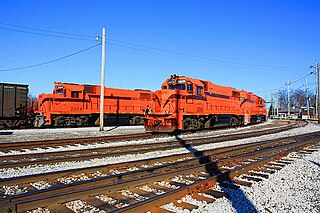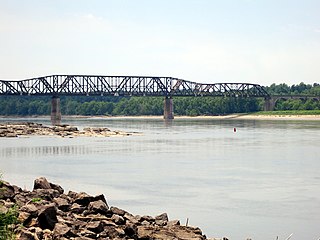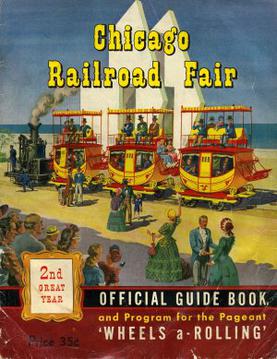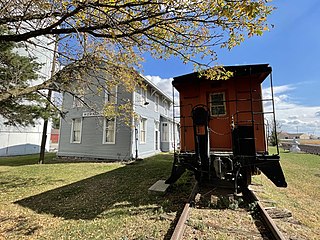
The Amstrad CPC is a series of 8-bit home computers produced by Amstrad between 1984 and 1990. It was designed to compete in the mid-1980s home computer market dominated by the Commodore 64 and the ZX Spectrum, where it successfully established itself primarily in the United Kingdom, France, Spain, and the German-speaking parts of Europe.

The Interstate Commerce Commission (ICC) was a regulatory agency in the United States created by the Interstate Commerce Act of 1887. The agency's original purpose was to regulate railroads to ensure fair rates, to eliminate rate discrimination, and to regulate other aspects of common carriers, including interstate bus lines and telephone companies. Congress expanded ICC authority to regulate other modes of commerce beginning in 1906. Throughout the 20th century, several of ICC's authorities were transferred to other federal agencies. The ICC was abolished in 1995, and its remaining functions were transferred to the Surface Transportation Board.

Metra is the commuter rail system in the Chicago metropolitan area serving the city of Chicago and its surrounding suburbs via the Union Pacific Railroad, BNSF Railway, and other railroads. The system operates 242 stations on 11 rail lines. It is the fourth busiest commuter rail system in the United States by ridership and the largest and busiest commuter rail system outside the New York City metropolitan area. In 2021, the system had a ridership of 14,080,700, or about 97,100 per weekday as of the second quarter of 2022. The estimated busiest day for Metra ridership occurred on November 4, 2016—the day of the Chicago Cubs 2016 World Series victory rally.

The Chicago Great Western Railway was a Class I railroad that linked Chicago, Minneapolis, Omaha, and Kansas City. It was founded by Alpheus Beede Stickney in 1885 as a regional line between St. Paul and the Iowa state line called the Minnesota and Northwestern Railroad. Through mergers and new construction, the railroad, named Chicago Great Western after 1892, quickly became a multi-state carrier. One of the last Class I railroads to be built, it competed against several other more well-established railroads in the same territory, and developed a corporate culture of innovation and efficiency to survive.

The Soo Line Railroad is the primary United States railroad subsidiary of the Canadian Pacific Railway, one of seven U.S. Class I railroads, controlled through the Soo Line Corporation. Although it is named for the Minneapolis, St. Paul and Sault Ste. Marie Railroad (MStP&SSM), which was commonly known as the Soo Line after the phonetic spelling of Sault, it was formed in 1961 by the consolidation of that company with two other CP subsidiaries: The Duluth, South Shore and Atlantic Railway, and the Wisconsin Central Railway. It is also the successor to other Class I railroads, including the Minneapolis, Northfield and Southern Railway and the Chicago, Milwaukee, St. Paul and Pacific Railroad. On the other hand, a large amount of mileage was spun off in 1987 to Wisconsin Central Ltd., now part of the Canadian National Railway. The Soo Line Railroad and the Delaware and Hudson Railway, CP's other major subsidiary, presently do business as the Canadian Pacific Railway. Most equipment has been repainted into the CP scheme, but the U.S. Surface Transportation Board groups all of CP's U.S. subsidiaries under the Soo Line name for reporting purposes. The Minneapolis headquarters are located in the Canadian Pacific Plaza building, having moved from the nearby Soo Line Building.

The Chicago South Shore and South Bend Railroad, also known as the South Shore Line, is a Class III freight railroad operating between Chicago, Illinois, and South Bend, Indiana. The railroad serves as a link between Class I railroads and local industries in northeast Illinois and northwest Indiana. It built the South Shore Line electric interurban and operated it until 1990, when it transferred to the Northern Indiana Commuter Transportation District. The railroad is owned by the Anacostia Rail Holdings Company.

The Dakota, Minnesota and Eastern Railroad is a wholly owned U.S. subsidiary of the Canadian Pacific Railway. Before its purchase, it was the largest Class II railroad in the United States, operating across South Dakota and southern Minnesota in the Northern Plains of the United States. Portions of the railroad also extended into Wyoming, Nebraska, Iowa, and Illinois. It interchanged with all seven U.S. Class I railroads.

The Iowa, Chicago and Eastern Railroad (IC&E) was a Class II railroad operating in the north central United States. It has been controlled by the Canadian Pacific Railway and operated as a part of its system since October 30, 2008. Formerly, the IC&E was jointly owned with the Dakota, Minnesota and Eastern Railroad by Cedar American Rail Holdings (CARH), making the combined system the largest class II railroad in the United States. Created by the purchase of I&M Rail Link, IC&E commenced operations on July 30, 2002. The 1,400-mile (2,300 km) line, based in Davenport, Iowa, serves the states of Illinois, Iowa, Missouri, Minnesota and Wisconsin. Principal commodities include chemicals, coal, steel, automobiles, and agricultural products. Train dispatching is performed at a joint DM&E/IC&E facility in Sioux Falls, South Dakota. On December 26, 2008, the IC&E was merged into parent CARH, which immediately merged into the DM&E.

The Elgin, Joliet and Eastern Railway was a Class I railroad, operating between Waukegan, Illinois and Gary, Indiana. The railroad served as a link between Class I railroads traveling to and from Chicago, although it operated almost entirely within the city's suburbs, and only entered Chicago where it served the U.S. Steel South Works on the shores of Lake Michigan. Nicknames for the railroad included "The J" and "The Chicago Outer Belt Line". At the end of 1970, the EJ&E operated 164 miles of track and carried 848 million ton-miles of revenue freight in that year alone.
The Evansville and Crawfordsville Railroad Company was Evansville, Indiana's first railroad company. It was first chartered in 1853 by William D. Griswold, a lawyer in Terre Haute, Indiana. It was renamed Evansville and Terre Haute Railroad in 1877. It went on to be consolidated without railroads of the region into the Chicago & Eastern Illinois Railroad. Chauncey Rose was a key player in financing its construction.

The Thebes Bridge is a five span cantilever truss bridge carrying the Union Pacific Railroad across the Mississippi River between Illmo, Missouri and Thebes, Illinois. It is owned by the Southern Illinois and Missouri Bridge Company, now a Union Pacific subsidiary.

The Chicago Railroad Fair was an event organized to celebrate and commemorate 100 years of railroad history west of Chicago, Illinois. It was held in Chicago in 1948 and 1949 along the shore of Lake Michigan and is often referred to as "the last great railroad fair" with 39 railroad companies participating. The board of directors for the show was a veritable "Who's Who" of railroad company executives.

The Chicago, Fort Wayne and Eastern Railroad is a short line railroad offering service from Tolleston, Indiana to Crestline, Ohio, United States over the former Fort Wayne Line of the Pennsylvania Railroad. It began operations in 2004 as a division of the Central Railroad of Indianapolis (CERA), under the overall corporate ownership of RailAmerica. CFE operates 273 miles (439 km) of rail leased from CSX.
The Center for Plant Conservation (CPC) is a not-for-profit organization consisting of a network of more than 50 institutions. The mission is to conserve and restore the rare native plants of the United States and Canada. CPC represents a network of conservation partners, collectively known as CPC Participating Institutions (PIs), that collaboratively work to save the imperilling plants of the United States and Canada. CPC PIs maintain the CPC National Collection of Endangered Plants, a living conservation collection of imperilling plants. By working to collect and manage living seeds and plants, advancing the understanding of threats as well as the means to save these species, and communicating with partners within the CPC network, the CPC works to ensure the conservation of these rare plants.

Peebles, Wisconsin is an unincorporated community in the Town of Taycheedah in Fond du Lac County, Wisconsin. The community is located adjacent to the unincorporated community of Taycheedah. U.S. Route 151 runs through the community. Wisconsin Highway 149 used to run through the community at its western terminus until it was decommissioned in 2006. Taycheedah Correctional Institution is located in the town of Taycheedah several miles south of the community.
CPCS Transcom Limited is an international infrastructure development firm specialising in private sector participation in transportation and power infrastructure, operations, investment, policy and regulation. An Ottawa, Ontario-based company, CPCS operates in more than 80 countries worldwide, particularly in Africa and Southeast Asia. Established in 1996 via a merger of firms, Hickling Transcom and CPCS International, CPCS Transcom was recognized by the 1999 Canadian Information Productivity Awards for its "Comprehensive Information and Systems Core Business Strategy". CPCS is governed by a Board of Directors that includes a full complement of non-executive Directors.

Edwards is an unincorporated community in Peoria County, Illinois, United States. Edwards is located on Illinois Route 8 northwest of downtown Peoria. Edwards has a post office with ZIP Code 61528; the Post Office is now located on Dubois Road just south of Interstate 74 exit 82, 2.1 miles (3.4 km) north of the original Edwards.
Russell is an unincorporated community in Lake County, Illinois, United States. The community is located on Russell Road, a few miles east of Interstate 94, and was named for industrialist and political figure Russell Sage, who was connected with the Chicago, Milwaukee, St. Paul and Pacific Railroad which bisects the village. Russell is near the Wisconsin state line 5 miles (8.0 km) west of Winthrop Harbor. Russell has a post office with ZIP code 60075.

The Chicago, Milwaukee, St. Paul & Pacific Combination Depot-Hornick, also known as the Hornick Depot, is a historic building located in Hornick, Iowa, United States. The town was patted by the Chicago, Milwaukee, St. Paul & Pacific Railroad's land company when the railroad created a branch line from Manilla, Iowa to Sioux City. Completed in 1887, the railroad built this two-story frame structure to serve as its passenger and freight depot. It is one of six such depots that remain in Iowa, and the best preserved. These buildings were built from a standard design used by the railroad. The two-story stations included living quarters for the station manager because the towns had yet to develop when the depot was built. This was an island depot, with freight loaded on the north side and passengers boarded on the south. Decorative elements on this depot include lathe-turned wooden finials, angled wooden brackets, and bracketed door and window hoods. Passenger service ended in the 1950s, and grain was loaded here until 1980 when the Milwaukee Road abandoned the Sioux City branch line. The building was listed on the National Register of Historic Places in 1990. It has been converted into a local history museum.













